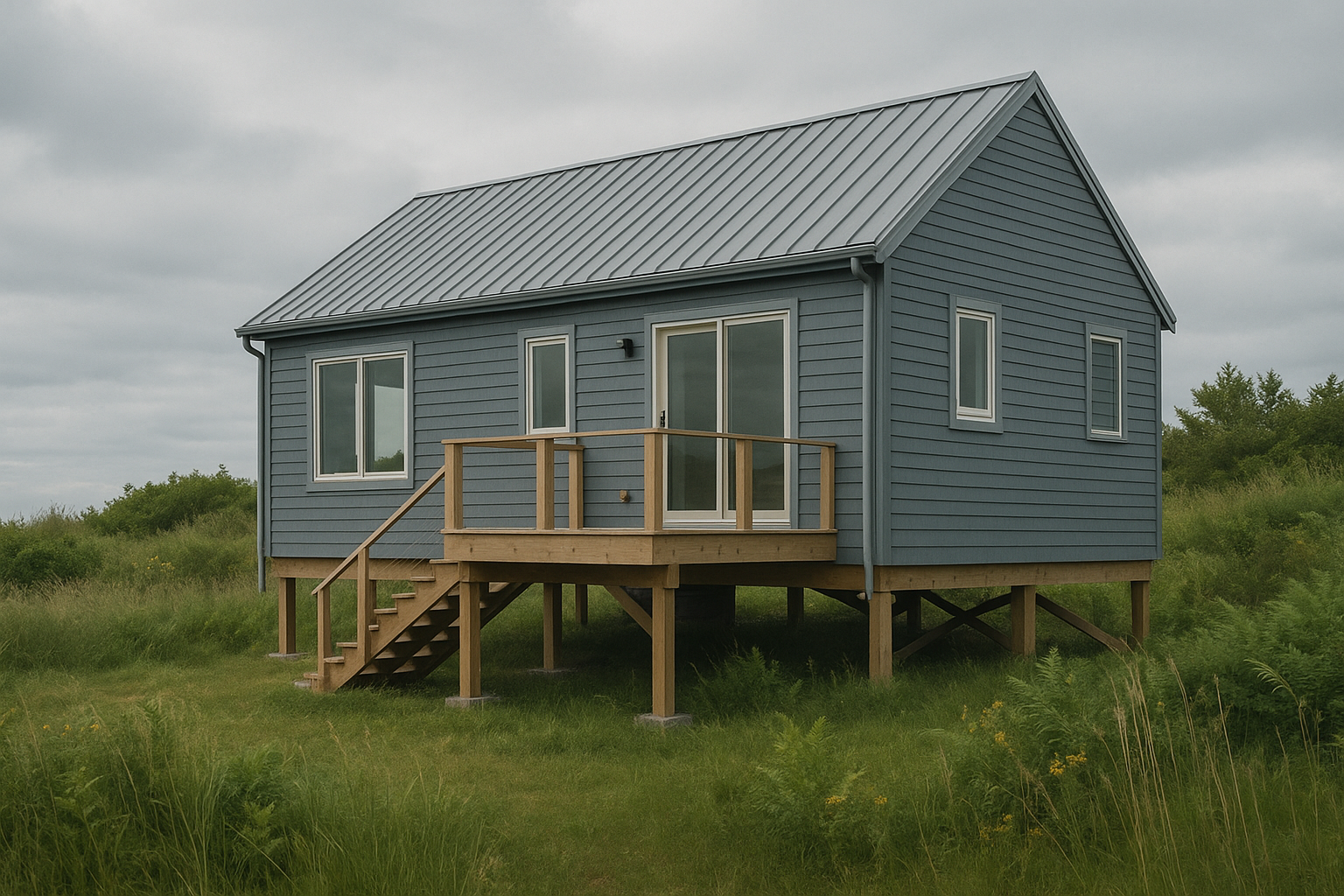Getting building permits and approvals in Nova Scotia can be a complex process, but proper preparation saves time, money, and headaches. Here's a quick overview of the key steps:
- Check Zoning Rules: Research zoning maps and bylaws, consult city officials, and assess rural property needs like septic systems and wells.
- Meet Building Codes: Ensure your project complies with fire safety, accessibility, energy efficiency, and structural requirements.
- Secure Development Permits: Required for multi-unit buildings or major site changes. Early planning speeds up approvals.
- Submit Building Permits: Prepare complete documents, including site plans, engineering reports, and energy compliance forms.
- Schedule Inspections: Pass inspections at key construction stages to stay on track.
- Obtain Final Approvals: Get your Occupancy Permit and ensure all systems meet code before opening your building.
Pro Tip: Work with experienced professionals and consider pre-designed layouts to save time and avoid costly errors. A well-planned project can reduce delays by up to two months.
Ready to dive in? Let’s break it down step by step.
2. Introduction to Permitting, Planning, Licensing & ...
Step 1: Check Zoning Rules
Before diving into design plans, take the time to research your property's zoning regulations. This step determines what you can build and avoids expensive changes later.
Understanding Zoning Maps and Bylaws
The Halifax Regional Municipality (HRM) offers detailed zoning maps and land use bylaws online. These documents highlight key factors like:
- Maximum building height
- Lot coverage limits
- Required setbacks
- Permitted unit counts
- Parking requirements
These details help you understand your options and prepare for discussions with city officials.
For instance, a duplex project near Truro required reviewing Colchester County's zoning maps. The R-2 zoning allowed for a 3,200 sq. ft. side-by-side design while meeting setback rules [1].
Consulting with City Officials
Book a free pre-application meeting with municipal planning staff. These meetings help confirm your understanding of zoning rules, flag potential issues early, and provide updates on bylaw changes.
Special Considerations for Rural Properties
For rural properties, hire a professional to assess soil conditions for a septic system, test well water quality and quantity to meet provincial standards, and check for environmental constraints like wetlands or protected species. Early assessments made a rural duplex project near Truro run more smoothly [1]. These zoning checks lay the groundwork for meeting building code requirements.
Step 2: Meet Building Codes
Once zoning requirements are confirmed, the next step is ensuring your project aligns with building codes. The National Building Code of Canada, combined with Nova Scotia's specific regulations, sets strict rules to guarantee construction safety and quality.
Working with Design Professionals
Partnering with a design-build team can simplify the process by combining design, engineering, and construction into one streamlined operation. This approach helps ensure your project meets all code requirements efficiently.
"On my last project, each sub blamed the other. With Helio, hitches were resolved in-house, eliminating delays." - Michael T., Real Estate Investor [1]
After finalizing your designs, shift your focus to meeting the necessary code standards.
Key Code Requirements
Nova Scotia's building codes emphasize several critical areas:
- Fire safety: Proper separations to reduce fire risks.
- Accessibility: Required for buildings with four or more units.
- Energy efficiency: Standards to improve performance and reduce costs.
- Structural integrity: Designed for local climate and conditions.
- Soundproofing: Ensures comfort for tenants.
For example, a 4-plex project in Nova Scotia successfully addressed these factors early in the design phase. The result? The project was completed in just nine months, with all units pre-leased, generating $9,600 in monthly rental income [1].
Once your plans meet these requirements, the next step is choosing the right builder.
Choosing a Builder
Selecting a builder with experience in Nova Scotia's codes is essential. Look for these qualities:
| Quality | Why It Matters |
|---|---|
| Fixed-Price Contracts | Avoids unexpected costs during construction. |
| Integrated Services | Ensures one point of responsibility for compliance. |
| Local Experience | Familiarity with Nova Scotia's specific rules. |
| Pre-designed Options | Provides layouts already approved for compliance. |
A great example is a duplex project in Colchester, Nova Scotia. Completed at $165 per square foot within seven months, the property met all code requirements and appraised at $830,000. This shows that meeting code standards doesn’t just ensure safety - it can also boost profitability [1].
Step 3: Development Permits
When You Need One
You’ll need a development permit for projects involving four or more units, properties in specific zones, or major changes to the site. For instance, Michael needed one for his 4-plex project to ensure the site layout, grading, and landscaping met local standards before construction could begin.
Application Timeline
Understanding the timeline for your permit is crucial. The process usually includes pre-application consultations, preparing documents, municipal reviews, and final approval. Timelines can vary depending on the project and location, but being well-prepared can help things move faster. For example, Helio’s duplex project in Colchester was completed in seven months, while another 4-plex took nine months when all documentation was ready. This highlights the importance of early planning, as mentioned in earlier steps.
Tips to Speed Up Your Application
Here are some ways to keep the process moving:
- Meet with municipal planners early to understand requirements
- Prepare all necessary studies and documents before applying
- Use pre-approved layouts that comply with local standards
- Submit detailed plans, including surveys and engineering reports
- Share clear timelines and phasing plans for your project
A team that handles design, engineering, permitting, and construction can help you avoid unnecessary delays. Once you’ve secured your development permit, you’ll be ready to move on to the building permit application in the next phase.
sbb-itb-16b8a48
Step 4: Submit Building Permit
Required Documents
To apply for a building permit in Nova Scotia, you’ll need to gather several key documents:
- Completed building permit application form
- Detailed construction drawings and site plans
- Structural engineering documents
- Energy efficiency compliance forms
- Property survey (dated within the last two years)
- Lot grading plan
- Mechanical and electrical drawings
- Truss layouts and specifications
- Foundation plans with dimensions
- Building section details
If the property is in a rural area, you might also need approved septic system designs and well permits, depending on the situation.
Application Methods
In the Halifax Regional Municipality (HRM), there are two ways to submit your application:
| Submission Type | Processing Time | Best For |
|---|---|---|
| Online Portal | 2–4 weeks | Urban projects, standard builds |
| Paper Submission | 3–6 weeks | Rural areas, complex projects |
The online portal allows you to upload documents digitally and track the process in real time. For rural municipalities outside HRM, paper submissions are still the norm, though some are starting to adopt digital systems.
Review Process
The review process typically takes 2 to 6 weeks, depending on how complex the project is. During this time, officials will check structural integrity, fire safety, code compliance, zoning, site drainage, and energy standards.
"They cut a full two months off my usual build - those extra rents basically covered my closing costs!" – James R. [1]
Michael T.’s 4-plex project is a great example of how preparation pays off. By submitting all required documents upfront, he secured permits within the standard timeframe. With detailed plans costing $173 per square foot, his project was completed in just nine months [1].
To keep your application on track:
- Submit all required documents in the correct format
- Make sure drawings meet municipal standards
- Resolve any property-related issues ahead of time
- Include detailed specs for building systems
- Provide accurate and clear contact information
Once your permit is approved, display the permit card at the construction site and keep the approved plans on hand for inspections. This step ensures your project is ready for the next phase: construction inspections.
Step 5: Construction Inspections
With permits approved, it's time to focus on construction inspections - an essential step before final approvals.
Inspection Checklist
Once your building permit is approved, multiple inspections are required at various stages of construction. Here's a breakdown of when these inspections typically happen:
| Construction Stage | Required Inspection | Typical Timeline |
|---|---|---|
| Site Preparation | Footings inspection before concrete | 1–2 days notice |
| Foundation | Inspection of foundation walls and drainage | Before backfill |
| Framing | Review of structural framing and sheathing | After roof/windows |
| Building Systems | Assessment of plumbing, electrical, and HVAC systems | Before drywall |
| Insulation | Check of vapour barrier and insulation | Before covering |
| Final | Occupancy inspection | At project completion |
Each inspection must be completed and passed before moving to the next phase. Keep your approved plans on-site for the inspector to review.
Schedule Inspections Early
Avoid delays by booking inspections well ahead of time. Most municipalities in Nova Scotia require at least 48–72 hours' notice for inspection requests. Here are some helpful tips:
- Schedule inspections as construction nears completion.
- Confirm specific requirements with your local building department.
- Have all necessary documentation prepared.
- Ensure the site is safe and accessible.
- Keep inspection areas clean and ready.
Handling Failed Inspections
If an inspection fails, you'll receive a report detailing what needs to be fixed. Common reasons for failure include:
- Deviations from approved plans
- Improper installation methods
- Missing safety elements
- Incomplete work
- Poor workmanship
To stay on track, document the issues, create a plan to address them, and schedule a re-inspection as soon as possible. Keep all stakeholders informed during this process.
Using a project management platform can simplify coordination between contractors and trades, helping ensure fixes are made quickly and efficiently [1].
These inspections are key to securing your final approval and moving forward with your project.
Step 6: Final Approvals
Securing Occupancy Approval
Once inspections are complete, the next step is to get an Occupancy Permit. This confirms that all systems meet code requirements. Officials will check:
- Fire safety systems, including smoke and carbon monoxide detectors
- Plumbing and electrical systems
- Ventilation and heating systems
- Overall building safety and compliance with regulations
Special Requirements for Multi-Unit Buildings
If you're working on a multi-unit building, there are extra steps to ensure tenant safety. These include:
- Approval from the Fire Marshal, covering fire separations and sprinkler systems
- Electrical Safety certification for each individual unit
- Accessibility compliance for buildings with four or more units
- Final sign-offs for HVAC and plumbing systems
Once all certifications are secured, your project is ready to move forward.
Wrapping Up the Project
After receiving all necessary approvals, you can complete the final steps to make your building operational:
- Obtain the official Occupancy Permit
- Resolve any outstanding municipal requirements
- Finalize insurance documentation
- Complete operational preparations
A great example of this process in action is a duplex project near Truro, Nova Scotia. This 3,200-square-foot development cost $168 per square foot to build and was appraised at $830,000 after completion [1]. It highlights how thorough planning and a smooth approval process can create immediate value.
Next Steps
Collaborate with Professionals
Team up with experienced professionals to simplify the process of obtaining permits in Nova Scotia. For example, Michael T. used a design-build approach to complete his 4-plex in just 9 months at $173 per square foot, with all units pre-booked before completion [1].
Key elements to focus on include:
- Ensuring designs and engineering comply with local codes
- Using fixed-price contracts to avoid unexpected costs
- Keeping schedules on track with project management tools
- Choosing a single team to handle design, engineering, and construction
Once you’ve established a strong approach, look into additional strategies to further improve your project’s efficiency.
Tools and Strategies to Consider
In addition to expert guidance, certain tools and strategies can help speed up your development process. Pre-marketing, advanced scheduling tools, and efficient designs are just a few ways to boost your project’s success [1].
Some key methods include:
- Pre-marketing: Attract tenants or buyers before your project is finished
- AI-powered scheduling: Minimize delays and streamline construction timelines
- Efficient design: Maximize usable space with smart layouts
- Integrated teams: Use one team for design, engineering, and construction to keep everything running smoothly



